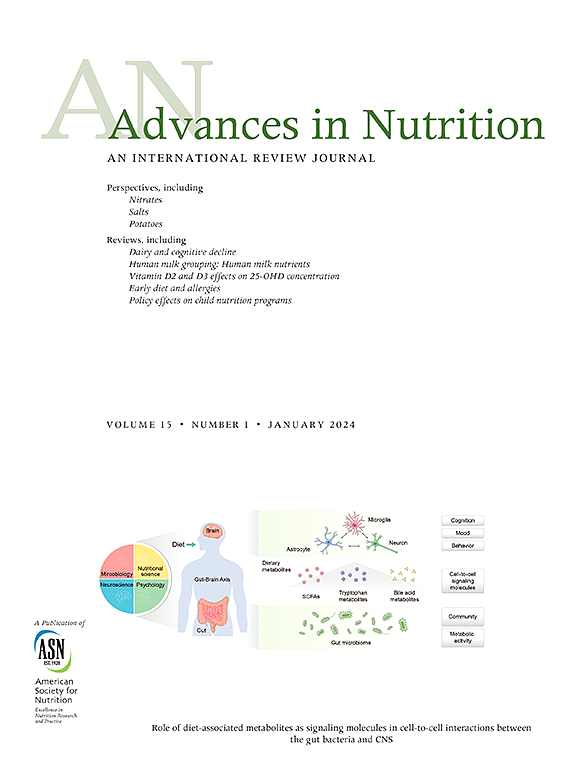膳食糖摄入量与2型糖尿病发病风险:前瞻性队列研究的系统回顾和剂量-反应荟萃分析
IF 9.2
1区 医学
Q1 NUTRITION & DIETETICS
引用次数: 0
摘要
目的:探讨膳食糖与T2D发病的量效关系。方法:检索MEDLINE、Embase、CINAHL、Web of Science和Cochrane数据库,检索截至2024年7月9日报告健康成人(Prospero ID: CRD42023401800)按膳食糖(总糖、游离糖、添加糖、果糖、蔗糖)类别或两种饮料来源(非饮食SSB、果汁)发生T2D风险的前瞻性队列。对每次暴露拟合线性和受限三次样条剂量反应模型,并计算研究特定斜率和置信区间(ci)。采用q统计量评估异质性。使用ROBINS-E工具评估偏倚风险,采用GRADE方法评估证据的确定性。结果:在10384项研究中,纳入了29个队列:SSB:18 (n = 541,288);果汁:14 (n = 490,413);蔗糖:7 (n = 223238);总糖:4 (n = 109,858);果糖:5 (n = 158,136);添加糖:2 (n = 31,004)。研究在欧洲(13)、美国(11)、亚洲(6)、澳大利亚(4)和拉丁美洲(3)进行。每增加一份SSB和果汁,患T2D的风险就会增加(RR: 1.25;95% CI: 1.17-1.35, RR: 1.05;95% CI分别为1.00-1.11;温和的确定性)。相比之下,总糖和蔗糖摄入量20 g/d与T2D呈负相关(RR: 0.96;95% ci: 0.94-0.98;低确定性;RR: 0.95;95%置信区间:0.91——结论:这些发现表明,以饮料形式摄入的膳食糖(SSB和果汁)与发生糖尿病的风险有关。研究结果不支持膳食糖(即总糖和蔗糖),无论其类型和数量,始终与糖尿病风险增加有关的普遍假设。意义声明:本研究首次全面建立了膳食糖摄入量与T2D风险之间的剂量-反应关系,表明饮料中的糖(SSBs和果汁)会增加风险,而总糖、蔗糖、果糖和添加糖呈负相关或零相关。这些发现挑战了所有糖都会增加糖尿病风险的假设。本文章由计算机程序翻译,如有差异,请以英文原文为准。
Dietary Sugar Intake and Incident Type 2 Diabetes Risk: A Systematic Review and Dose-Response Meta-Analysis of Prospective Cohort Studies
The dose-response relationship between dietary sugar and type 2 diabetes (T2D) risk is uncertain. MEDLINE, Embase, CINAHL, Web of Science and Cochrane databases were searched through July 9, 2024 for prospective cohort studies reporting relative measures of incident T2D risk by categories of dietary sugar (total, free, added, fructose, sucrose) or 2 beverage sources (non-diet sugar-sweetened beverages [SSBs], fruit juice) in healthy adults. Linear and restricted cubic spline dose-response models were fitted for each exposure, and study-specific slopes and confidence intervals (CIs) were calculated. Heterogeneity was evaluated using Q-statistics. Risk of bias was evaluated using the Risk of Bias in Non-randomized Studies of Exposures (ROBINS-E) tool. The Grading of Recommendations Assessment, Development and Evaluation (GRADE) approach was applied to assess the certainty of evidence. Of 10,384 studies, 29 cohorts were included: SSB: 18 (n = 541,288); fruit juice: 14 (n = 490,413); sucrose: 7 (n = 223,238); total sugar: 4 (n = 109,858); fructose: 5 (n = 158,136); and added sugar: 2 (n = 31,004). Studies were conducted in Europe (13), United States (11), Asia (6), Australia (4), and Latin America (3). Each additional serving of SSB and fruit juice was associated with a higher risk of T2D (risk ratio [RR]: 1.25; 95% CI: 1.17, 1.35 and RR: 1.05; 95% CI: >1.00, 1.11, respectively; moderate certainty). In contrast, 20 g/d intakes of total sugar and sucrose were inversely associated with T2D (RR: 0.96; 95% CI: 0.94, 0.98; low certainty; and RR: 0.95; 95% CI: 0.91, <1.00; moderate certainty, respectively). No associations were found for added sugar (RR: 0.99; 95% CI: 0.96, 1.01; low certainty) or fructose (RR: 0.98; 95% CI: 0.83, 1.15; very low certainty). These findings suggest that dietary sugar consumed as a beverage (SSB and fruit juice) is associated with incident T2D risk. The results do not support the common assumption that dietary sugar (i.e., total sugar and sucrose), irrespective of type and amount, is consistently associated with increased T2D risk.
This study was registered in PROSPERO as CRD42023401800.
求助全文
通过发布文献求助,成功后即可免费获取论文全文。
去求助
来源期刊

Advances in Nutrition
医学-营养学
CiteScore
17.40
自引率
2.20%
发文量
117
审稿时长
56 days
期刊介绍:
Advances in Nutrition (AN/Adv Nutr) publishes focused reviews on pivotal findings and recent research across all domains relevant to nutritional scientists and biomedical researchers. This encompasses nutrition-related research spanning biochemical, molecular, and genetic studies using experimental animal models, domestic animals, and human subjects. The journal also emphasizes clinical nutrition, epidemiology and public health, and nutrition education. Review articles concentrate on recent progress rather than broad historical developments.
In addition to review articles, AN includes Perspectives, Letters to the Editor, and supplements. Supplement proposals require pre-approval by the editor before submission. The journal features reports and position papers from the American Society for Nutrition, summaries of major government and foundation reports, and Nutrient Information briefs providing crucial details about dietary requirements, food sources, deficiencies, and other essential nutrient information. All submissions with scientific content undergo peer review by the Editors or their designees prior to acceptance for publication.
 求助内容:
求助内容: 应助结果提醒方式:
应助结果提醒方式:


